Fermenting Cucumbers: Making Israeli Pickles
This post may contain affiliate links, view our disclosure policy for details.
Fermenting cucumbers is an easy way to preserve the summer harvest. In Israel, lacto-fermented cucumbers are basically Israeli pickles, the ones I grew up consuming by the gallon. let me show you how to make Israeli pickles!
There are so many ways to make pickles. Honestly, I didn’t know that there were so many ways to preserve cucumbers and make pickles until I landed here in the U.S. back in 2005. In my home country, Israel, we mostly eat pickles in brine (fermented cucumbers) and some people also like pickles that are preserved in a mixture of salt and vinegar but that’s it. They are the only two kinds.
I was amazed to find out that you can make sweet pickles and that there are so many different recipes for pickling cucumbers. So I got a bit excited and tried a few. I’d choose a different kind at the grocery store to find one that I liked so I could find and use a recipe for that kind of pickle to preserve my summer harvest.
Fermenting Cucumbers: Making Israeli Pickles…
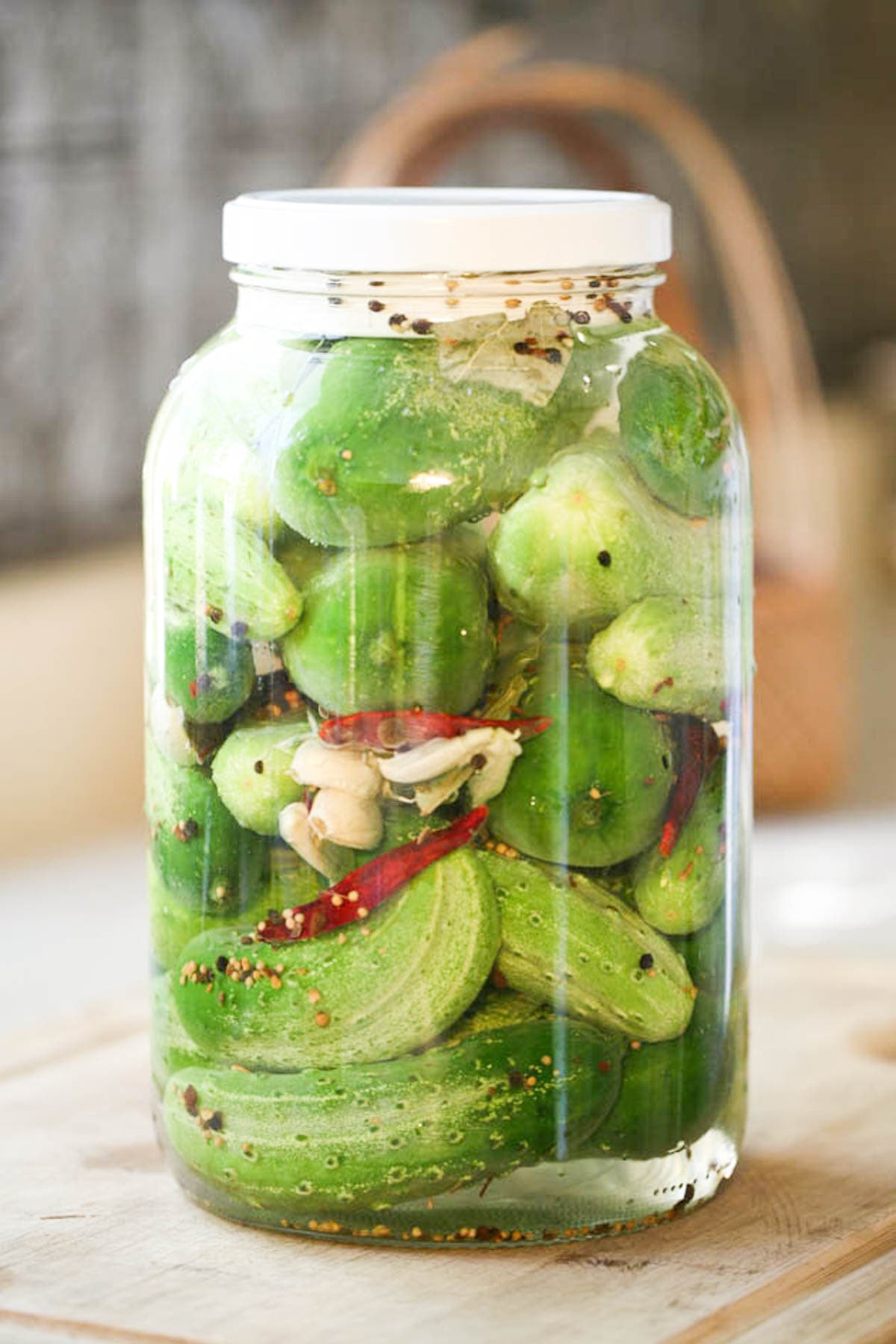
But… I just didn’t like any of them. I don’t like vinegar much and the sweet kind doesn’t sit well with me. The Hamburger pickles are probably the only kind I can eat but they don’t make me too excited. A normal person can’t live without pickles, I’m sure we all agree on that. So something had to be done.
And so, I set out to recreate my childhood pickles which meant fermenting cucumbers. But that wasn’t as easy as I thought it would be. The kinds of cucumbers they use in Israel for pickling is different than the kind we use here. Also, I’ve always just eaten them from a store-bought can, I didn’t have a family recipe to go by.
I’ve tried all kinds of things and it took some experimenting but I think that I can now safely say that I’ve found my recipe. The recipe that produces fermented cucumbers just like the ones I grew up eating. And I am super happy to say that it’s simple and takes only minutes to put together.
What is the Process of Lacto-Fermentation?
Lacto-fermentation means preserving food by using a brine mixture (salt dissolved in water). The brine creates an anaerobic, acidic environment in which bad bacteria can’t grow, therefore, we are able to keep the food longer.
The cool thing about lacto-fermentation is that it’s so simple! No boiling water baths, no special pressure pots or any special equipment is necessary. But maybe the best thing about lacto-fermentation is that in the process bacteria, probiotics, and enzymes that are beneficial to our digestive system are created so we actually increase the nutritional value of the food that we ferment.
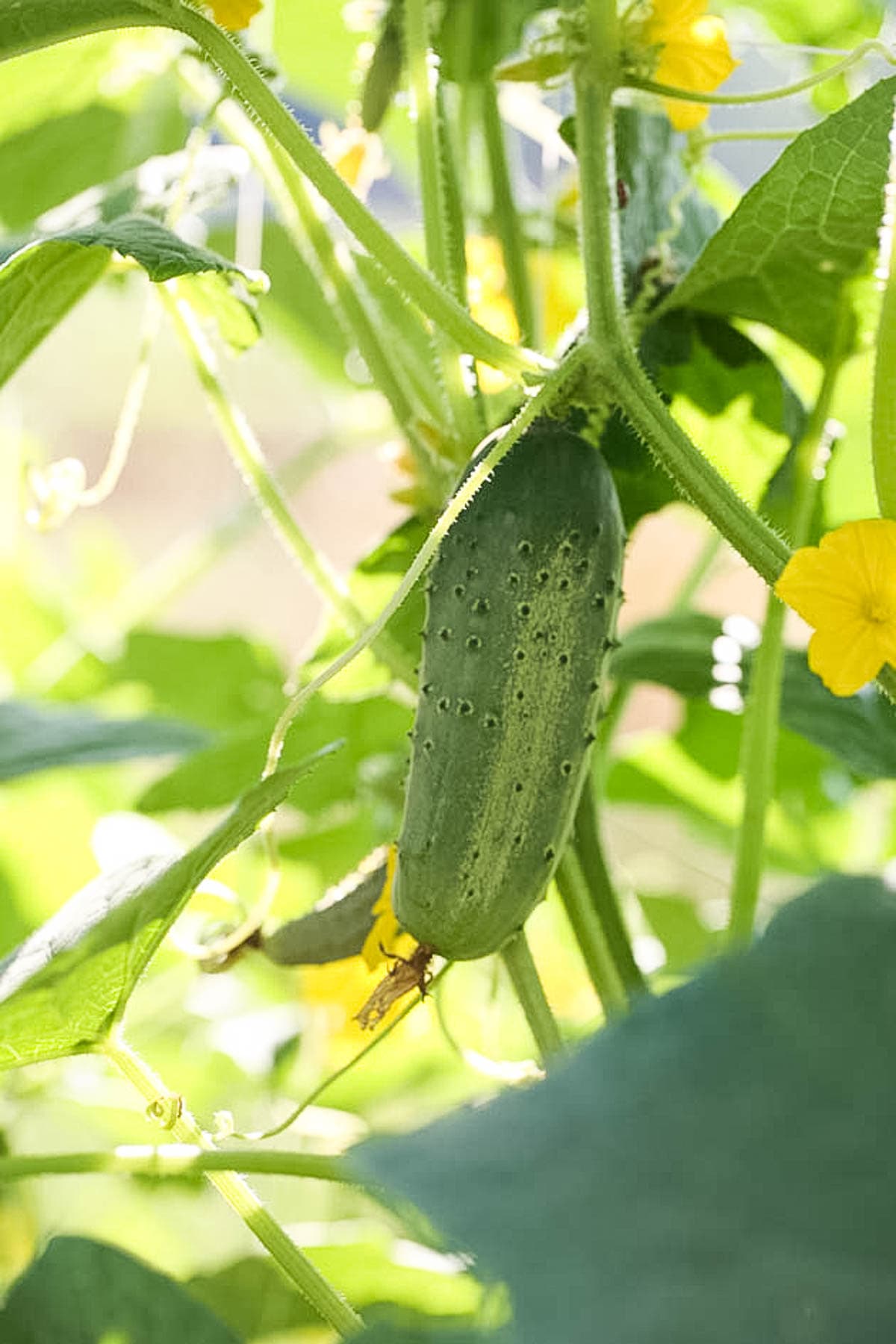
Tips For Success…
I am pretty sure that anyone who has ever fermented cucumbers will tell you that your success (crunchy and delicious pickles) depends on the cucumbers you start the process with. I am no different here. I grow my own pickling cucumbers and I recommend that you do the same. Here are a few tips…
- Grow a pickling variety – you can pickle slicing varieties, however, pickling varieties are better since they are smaller, firmer, and have thicker skin.
- Harvest small – harvest your pickling cucumbers when they are 3-4 inches long. Also, harvest in the cool morning hours.
- Pickle right away – if you have enough cucumbers to fill a jar, go ahead and ferment your cucumbers right away. The fresher they are, the better. Some say that it’s a good idea to keep your cucumbers in an ice bath until you can pickle them but I’ve never done that. If I can’t ferment my cucumbers right away, I keep them in the fridge.
- If you don’t grow your own – you can find a ton of pickling cucumbers at the local farmer’s market during the growing season. Make sure you choose the smaller ones and ask the farmer when they were picked.
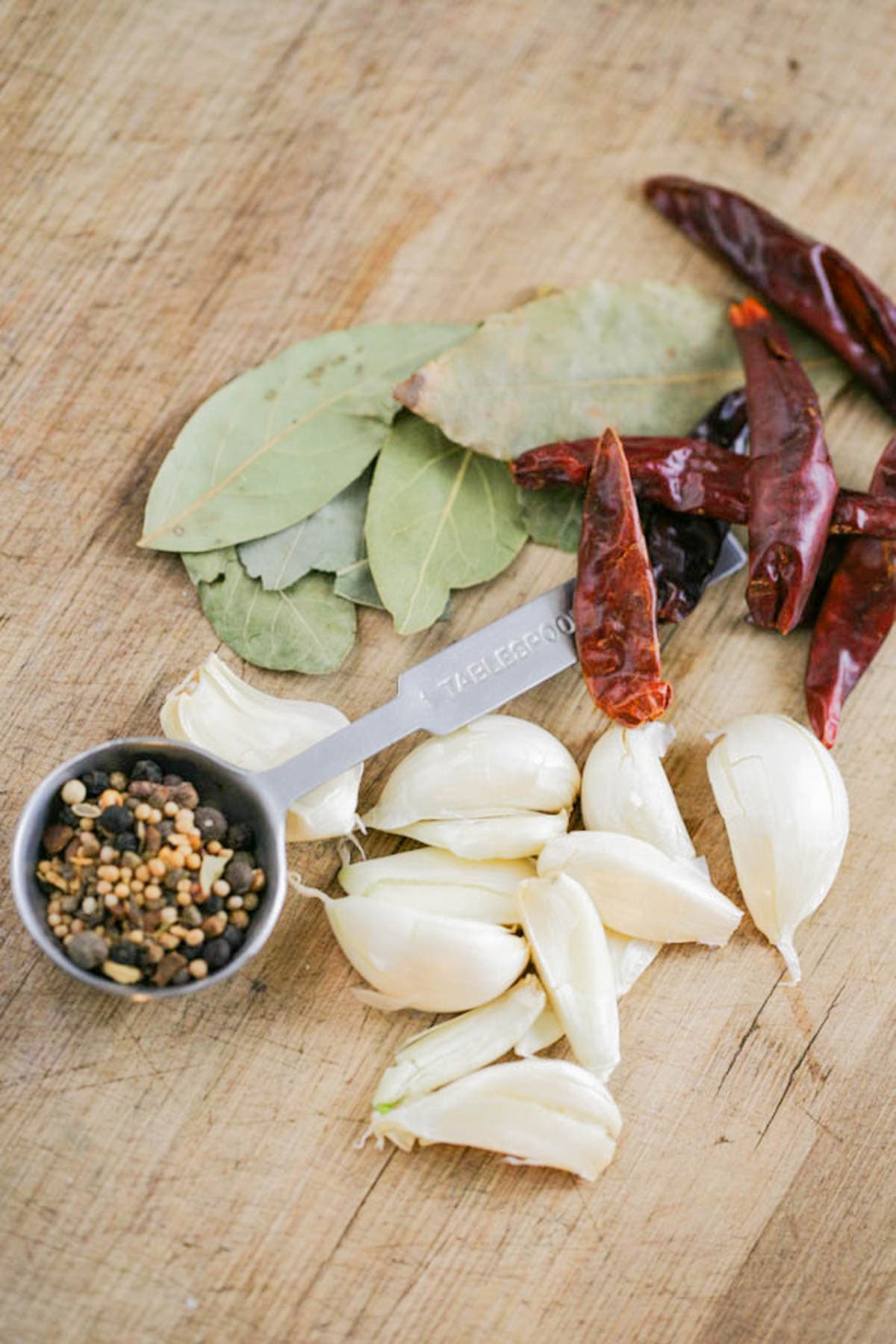
Ingredients…
This recipe makes a one-gallon jar of Israeli pickles.
- Pickling cucumbers – I can usually fit about 20-30 in a gallon jar depending on their size.
- 9 cloves of garlic – crushed but not peeled.
- 2 tablespoons Ball pickling spice
- 5 bay leaves
- 6 Japone chili peppers – or you can use other kinds or peppers like Cayenne or maybe Jalapeno.
- A few stems of fresh dill
- A couple of grape leaves – this is optional. Some say that grape leaves help the pickles stay crunchy longer.
- For the brine – use non-chlorinated water and non-iodized salt like canning salt, Kosher salt or sea salt. I like my pickles salty so I use one tablespoon of salt per one cup of water. You can do as little as one teaspoon of salt per one cup of water but no less.
Kitchen Tools…
- Measuring spoon
- 4-cup Measuring cup
- One gallon jar
- Fermentation weights – please don’t be like me and promise yourself every season that you are going to get fermentation weights and never get them. Just get fermentation weights, they’ll make your life much easier. If you don’t have fermentation weights or you don’t want to get them, you can use a plastic wide mouth freezer lid as I did here (update – I finally got fermentation weights and my life will never be the same!).
- Fermentation lid – during the fermentation process gas is created. We need to let this gas out once a day. There are fancy fermentation lids that save us this work, but they are completely optional. It only takes a second to “burp” the jar (more on this later).
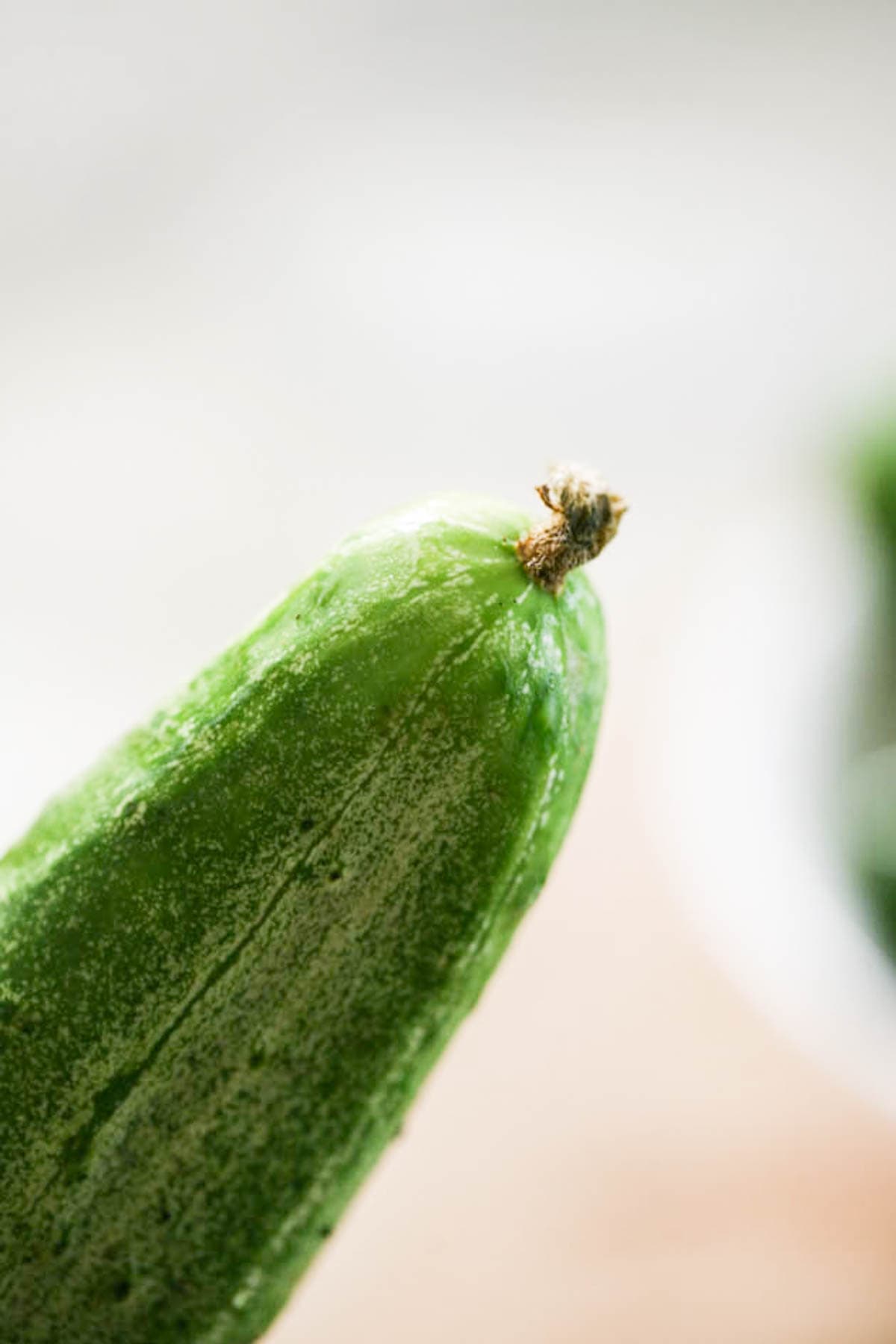
Should You Remove the Blossom End Before Fermenting Cucumbers?
Let’s focus on this question for a minute since there seem to be all kinds of opinions about it. A cucumber has two ends, the end with the stem (where it was connected to the plant) and the blossom end. Rumor has it in the U.S. that the blossom end contains enzymes that can cause the pickle to get mushy and therefore it is advised to remove it. I don’t know, people… I have never met a pickle in Israel that had this end removed and they were all perfectly crunchy.
However, if you are concerned about the blossom end, you have two options…
- Remove it – simply cut the blossom end and then wash your cucumbers before fermenting them.
- Blanch your cucumbers – bring a pot of water to a boil and add the cucumbers. Let them stay in the boiling water for 3 minutes before removing them right into an ice bath to stop the cooking. The boiling water will kill any enzymes. You can learn more about blanching in my blanching potatoes post.
I like to live on the edge though (and I am also a bit lazy but let’s not focus on that…) so I have to be honest and say that I simply wash my cucumbers with cold water and a sponge with a tiny bit of dish soap. I don’t remove the blossom end and I don’t blanch the cucumbers, ain’t nobody got time for that! And… My pickles always turn out great!
Watch Me Make Israeli Pickles…
How to Make Israeli Pickles Step by Step…
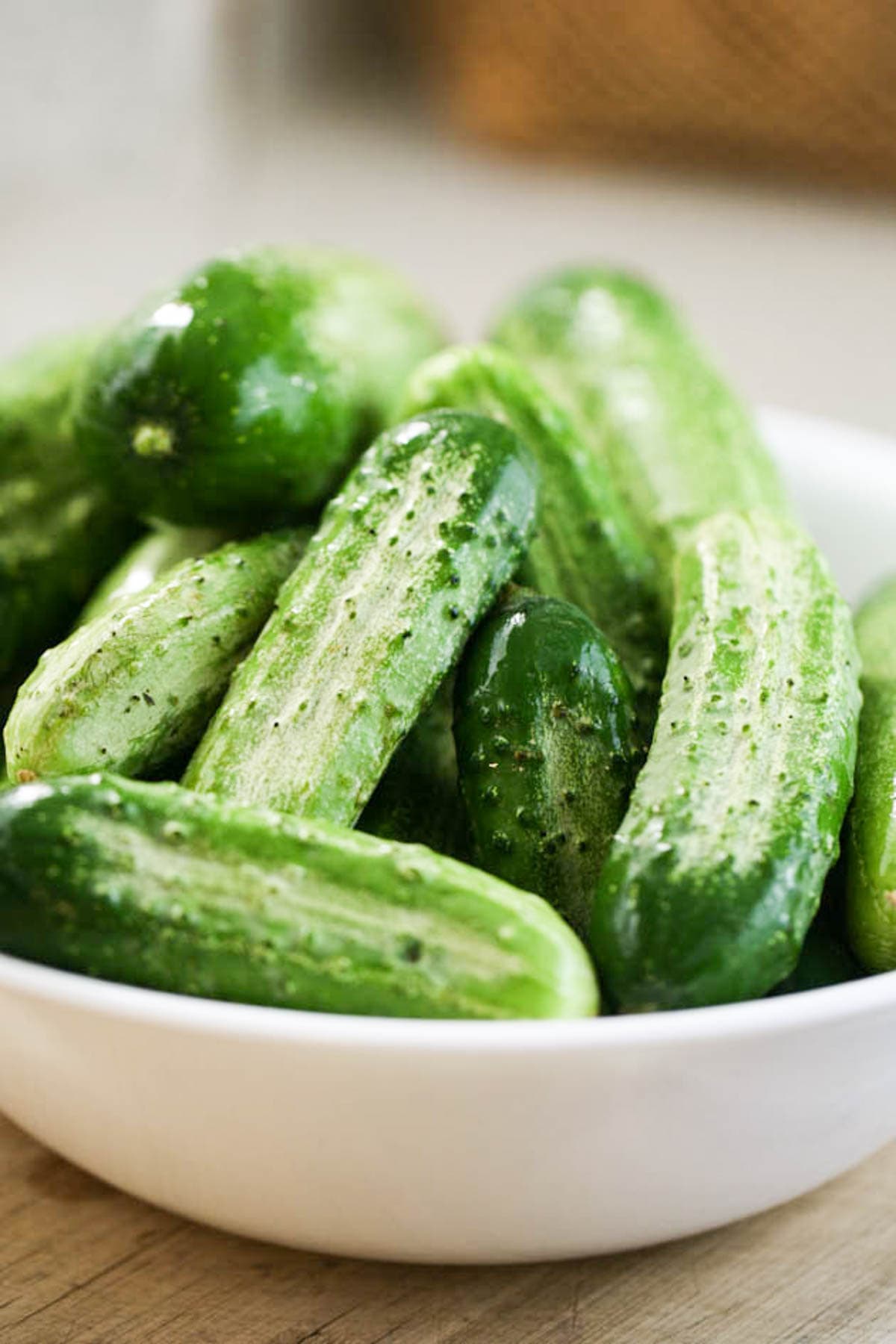
Step 1 – prepare the cucumbers. Start by washing the cucumbers and, if you want, remove the blossom end or blanch them.
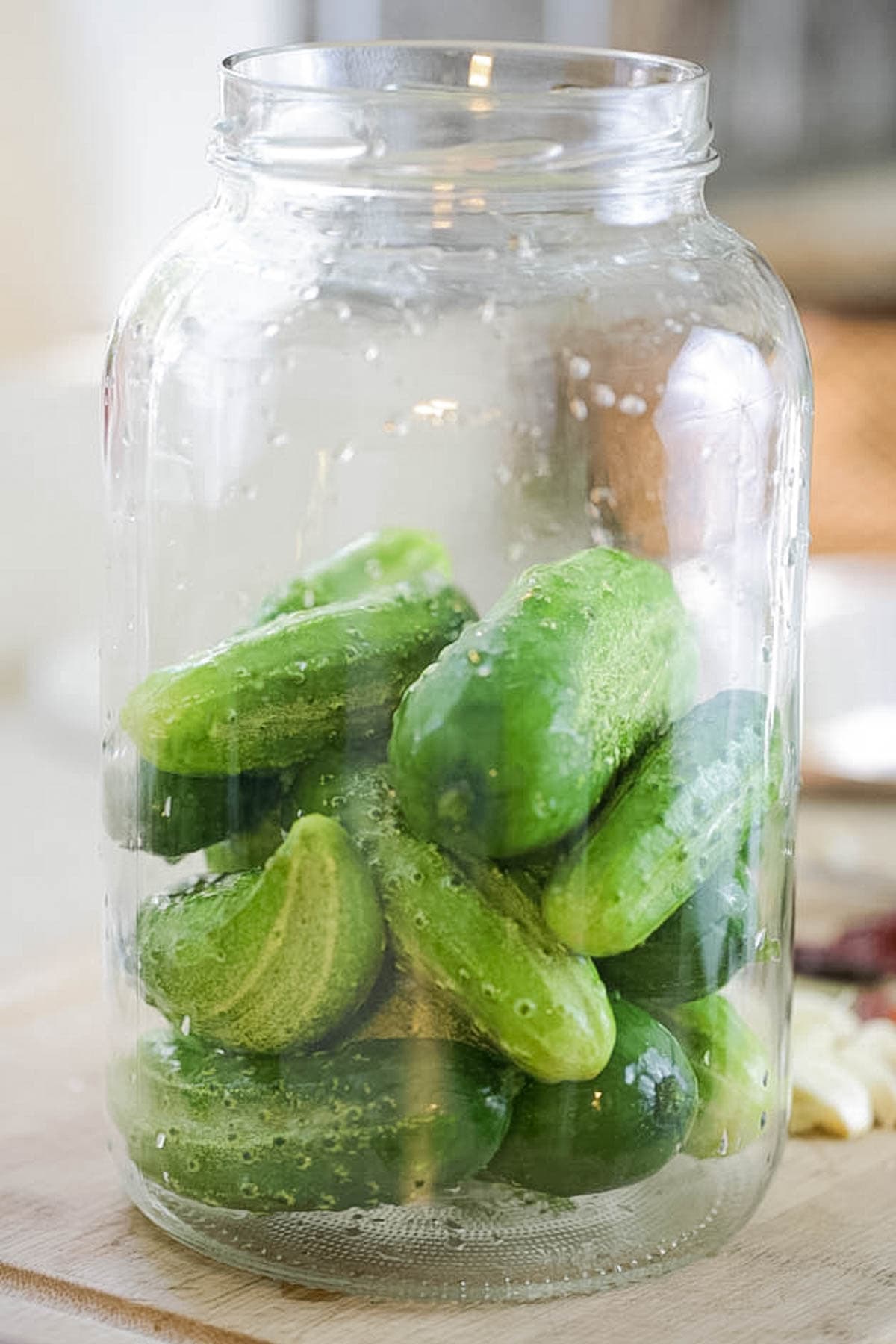
Step 2 – Pack the jar. Make sure to wash the jar well and then pack it half way with cucumbers…
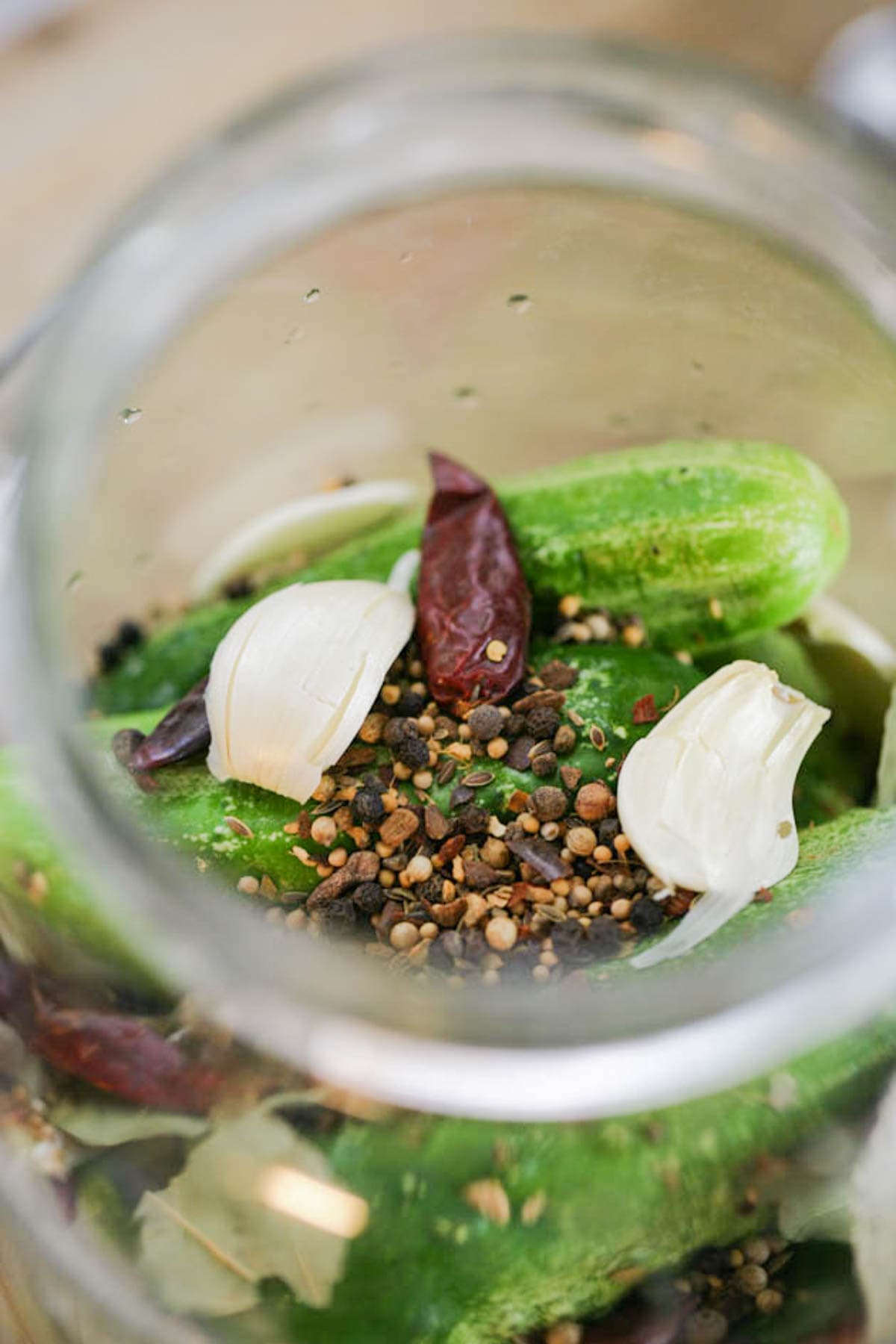
Next, add the garlic, peppers, and the rest of the seasonings…
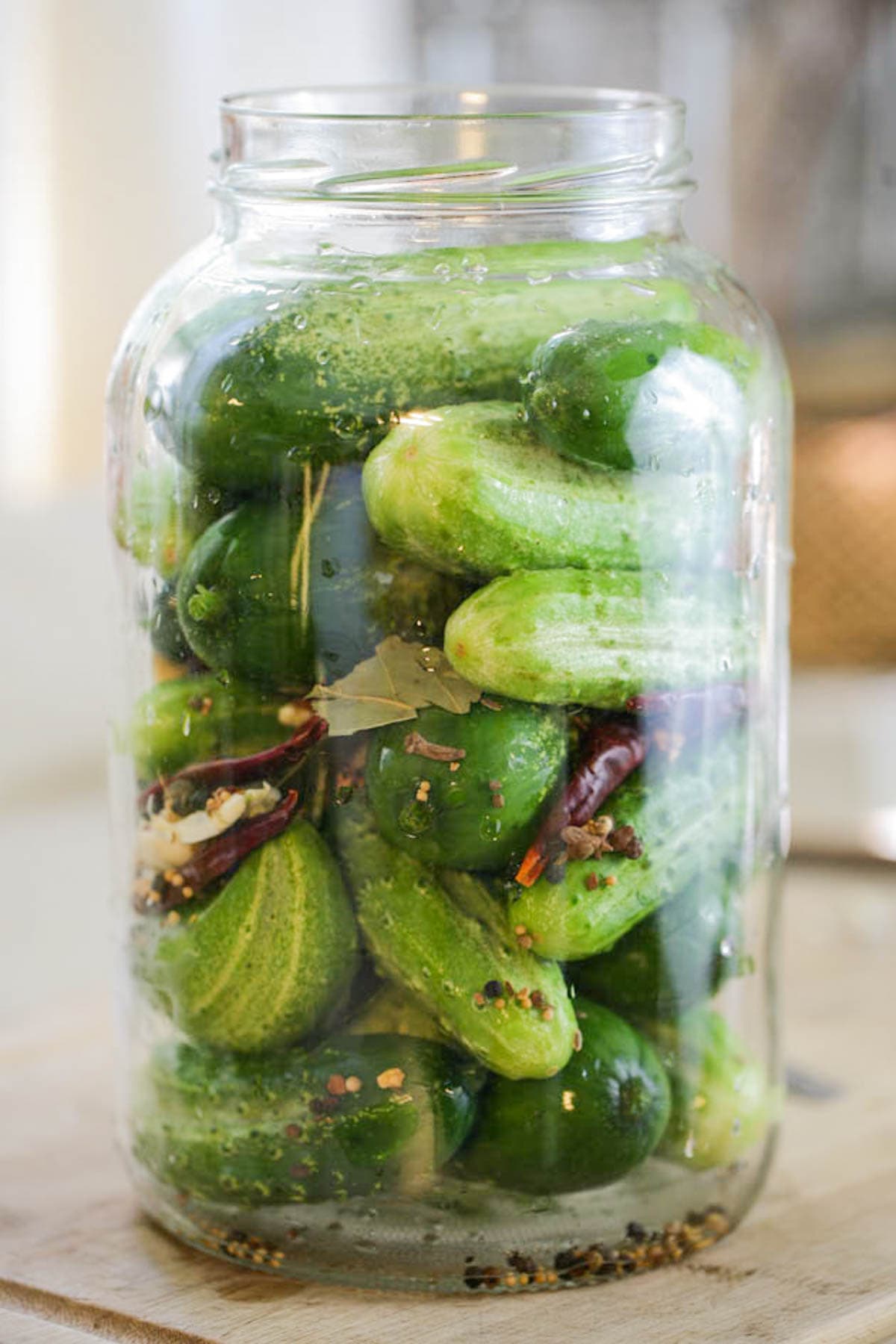
Before adding more cucumbers to fill the jar. Make sure to leave a couple of inches of headspace so there is room for the fermentation weight.
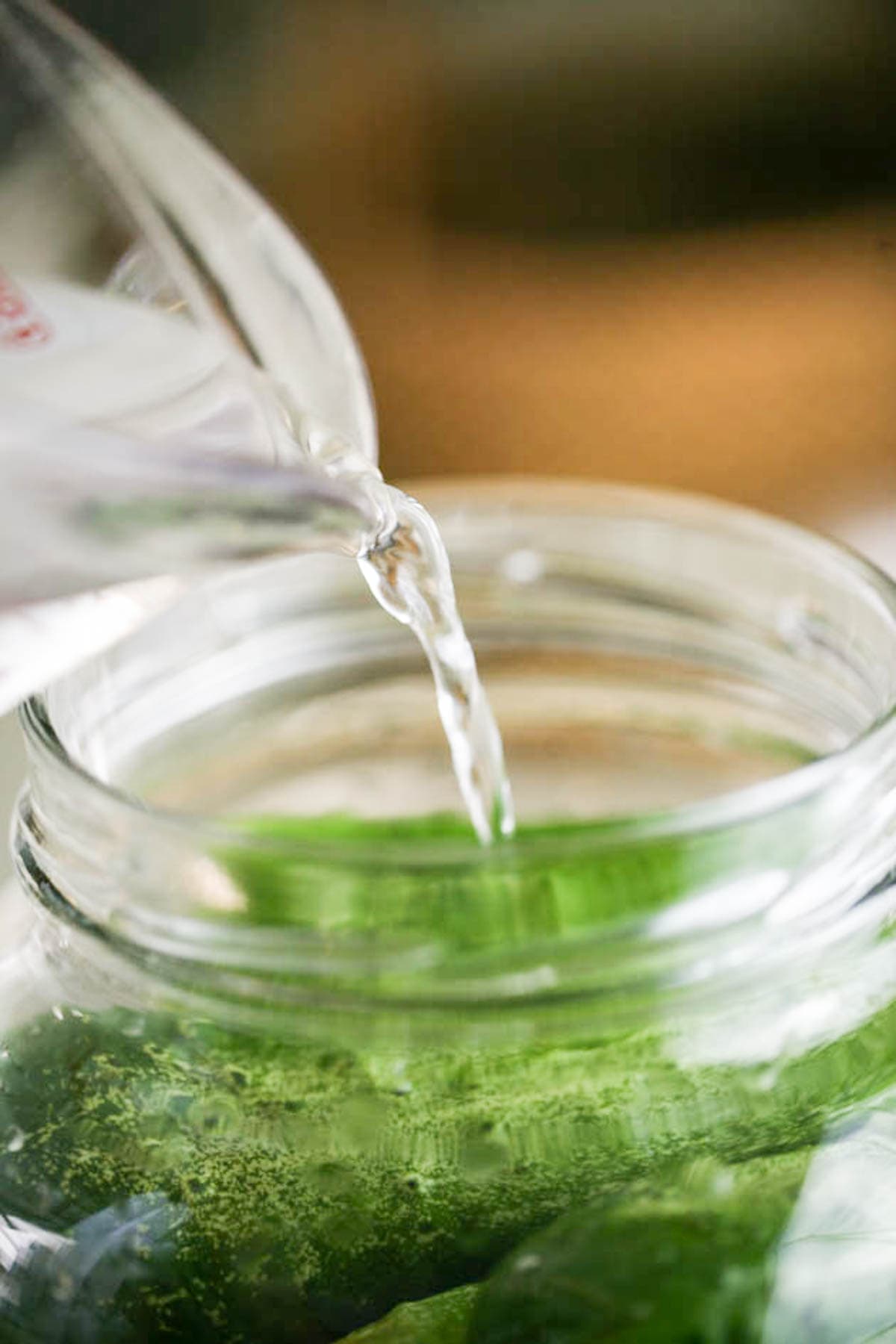
Step 3 – add the brine. Prepare the brine by dissolving one tablespoon of salt for each cup of water and add to the jar. Keep adding brine until the jar is filled. Leave about an inch of headspace.
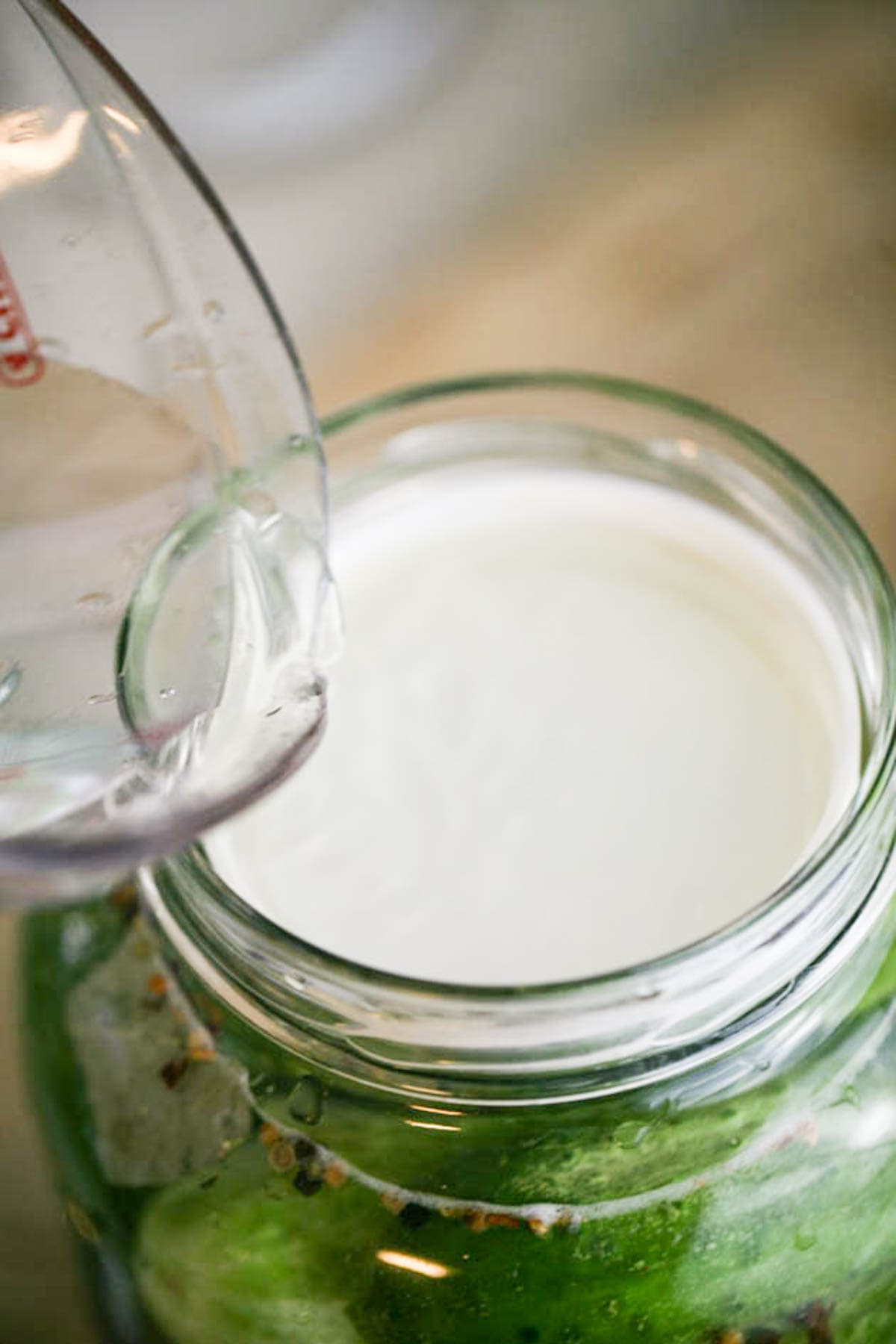
Now is the time to place the fermentation weight on top of the cucumbers. Since I didn’t have a fermentation weight, I used a plastic, wide-mouth freezer lid. I flipped it and placed it on the cucumbers. Pushed it down a bit and added a little more brine. This created a weight that kept the cucumbers under the brine which is what we want.

Step 4 – let the cucumbers ferment. Close the jar with its lid and place it on a plate. During the fermentation process some of the brine will spill out, the plate will catch it and save you some mess. Place the jar on the kitchen counter or somewhere at room temperature to ferment.
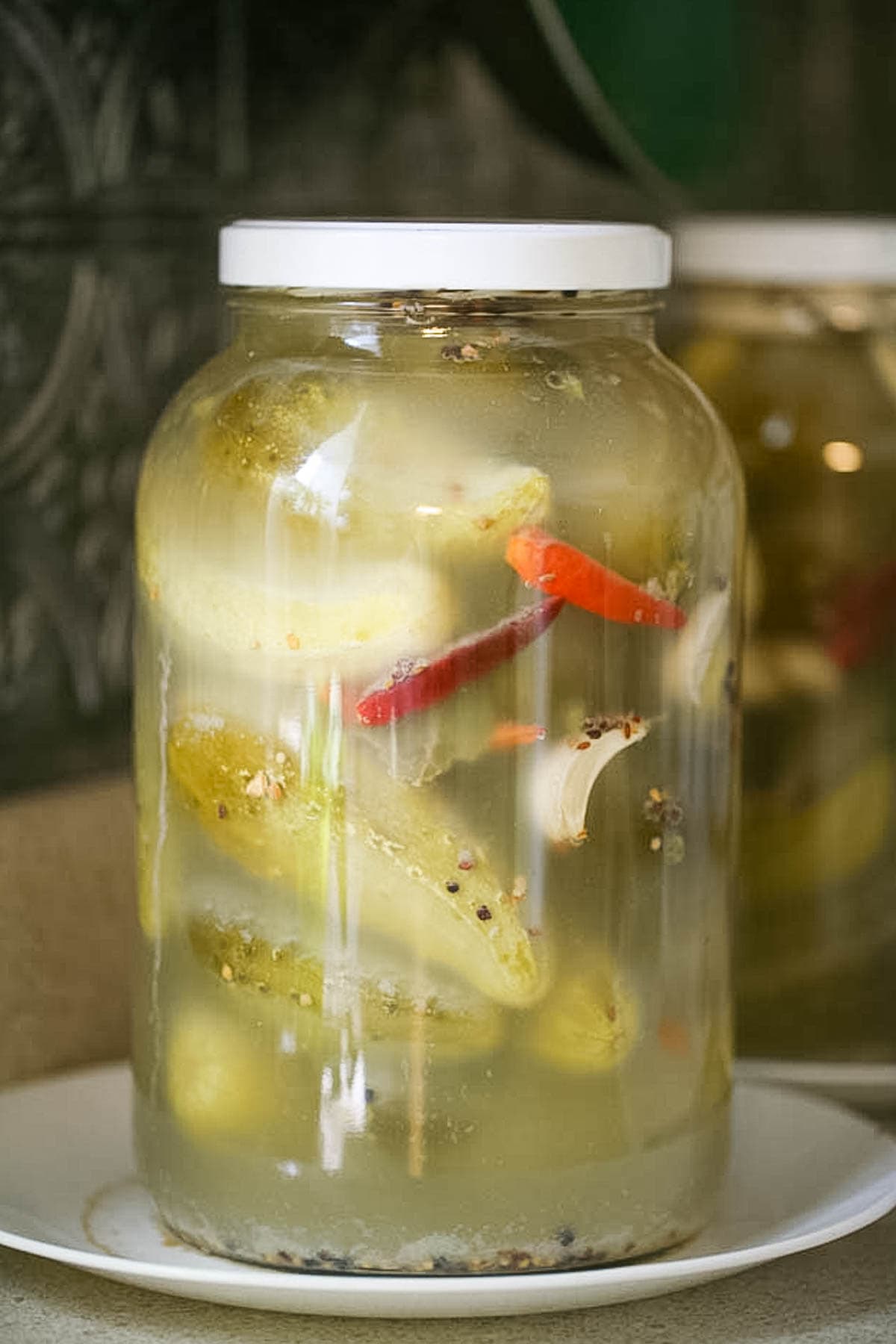
After a few days, you’ll notice that the brine becomes foggy and there is some bubble action close to the top of the jar. This just means that the fermentation process has begun! Remember to let the gas out, or in other words, to burp the jar. Once a day, twist the lid open, wait a few seconds, and twist it back to close the jar again. There is no need to open the jar all the way.

It takes a gallon jar about two weeks to finish fermenting. If you ferment cucumbers in a quart jar or half a gallon it will take less time. You’ll know when the fermentation process is done once the brine clears. It will never be as clear as it was at the beginning, but it will be much clearer than what it was during the fermentation process.
Storing Your Fermented Cucumbers…
The best thing to do is to store your pickles in the fridge or in a cool root cellar. I usually transfer my jar to the fridge (since I don’t have a root cellar) and once we are halfway through it I start fermenting the next jar.
Make sure that you always use a clean fork to fish a cucumber from the jar and that the pickles stay under the brine even when the jar is stored in the fridge.
I came by this article from the National Center for Home Preservation that explains how to can fermented foods and it’s definitely something that I want to try. However, I won’t be able to do that with a gallon jar, I’ll have to use quart jars instead.

Serving Israeli Pickles…
You can serve Israeli pickles just as you’d serve other kinds of pickles. I feel like they taste better when they are cold, so I let the jar chill a couple of days in the fridge before we open it. Here are a few serving ideas…
- Just serve these pickles as a healthy snack!
- Add them to an Israeli vegetable salad.
- Use them on a hamburger.
- Dice them and add to an egg salad or a tuna salad.
- Stick them in any kind of sandwich.
- Serve them as a side for fritters or a Mediterranean casserole.
Frequently Asked Questions…
Yes, you can ferment slicing cucumbers the same exact way. Try to use very small cucumbers.
There are no rules when it comes to the spices that you add to the jar. I find that this combination gives me pickles that are the closest in taste to the ones I grew up eating but you can change things around as you wish. Add dill or thyme. Add different kinds of peppers for more heat, add chili flakes or mustard seeds… Really, you can add anything you can come up with.
Yes, it’s ok. It’s surface scum or kahm yeast and it doesn’t hurt the fermented cucumbers. Simply scoop it up with a spoon and remove as much of it as you can, then keep enjoying your Israeli pickles. You can also wash the pickles in cold water before serving them.
Yes! I don’t like the taste of vinegar much so I prefer leaving it out but you can add it if you like. I do this in my preserving peppers recipe and you are welcome to check it out. For a gallon jar, you can add up to two cups of vinegar. Add the vinegar first, then add the brine, and when you are done, close the jar and give it a little shake to mix it all together. Then move on with the fermentation process the same way.
This is, hands down, my favorite way of preserving cucumbers! I really want to learn how to can those fermented cucumbers so I can always have jars and jars of them on the shelf. I hope that you’ll give this recipe a try and I hope that you find sour Israeli pickles tasty!
More Fermenting Tutorials…
- Lacto-Fermented Green Beans
- Fermenting Turnips
- Fermented Jalapenos
- Fermenting Beets
- Easy Fermented Radish
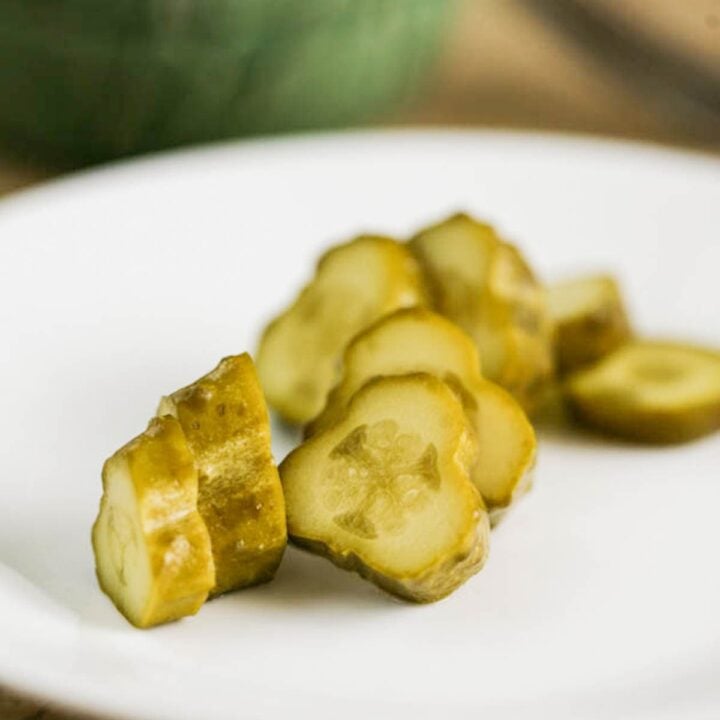
Israeli Pickles
This is how I ferment cucumbers to recreate my childhood Israeli pickles!
Ingredients
- 20 small cucumbers (or as many as you need in order to fill the jar)
- 9 cloves of garlic, crushed but not peeled
- 2 tablespoons Ball Mixed Pickling Spice
- 5 bay leaves
- 6 Japone chili peppers
- Fresh dill and fresh grape leaves (optional)
- Pickling, sea, or kosher salt and non-chlorinated water
Instructions
- Wash your pickling cucumbers well with a tiny bit of dish soap and cool water.
- Wash your gallon jar well with warm water and dish soap.
- Pack the cucumbers into the jar halfway through...
- Add the garlic, pickling spice, bay leaves, chili peppers. Add dill and grape leaves if you're using them...
- Finish packing the jar with more cucumbers. Leave about two inches of headspace.
- Dissolve one tablespoon of salt per one cup of water to make the brine (you'll probably need 6-8 cups of brine). Add the brine to the jar filling it all the way but leaving one inch of headspace.
- Add a fermentation weight to make sure all the cucumbers are under the brine. Add a little bit more brine over the weight if you need to.
- Place your jar on a plate to catch any liquid that is going to spill out during the fermentation process and set aside at room temperature to ferment.
- It will take about two weeks for the fermentation process to be done. You'll notice the brine becomes foggy and bubbly. There will also be some foam on the top. If you didn't use a special fermentation lid for the jar, make sure to "burp" the jar once a day. This means you need to twist the lid open, wait a few seconds, and twist to close it again.
- Your pickles are ready when the brine clears out a bit.
- Store your jar in the fridge or in a root cellar. Serve cold.
Notes
1. Make sure to use small pickling cucumbers. The best ones are 3 to 4 inches long. If you grow your own, pick them in the morning and ferment as soon as possible.
2. If this brine is too salty for you, you can reduce the salt as low as one teaspoon per cup of water but no less.
3. Feel free to change the spices any way that you want. Add different kinds of peppers to add more heat, add mustard seeds, chili flakes, dill, or whatever else you can come up with.
4. If you like the taste of vinegar, you can add up to two cups of vinegar to a gallon jar. Pack the jar, add the vinegar, then add the brine, and close the jar. Give it a little shake to mix the brine with the vinegar. Everything else is the same.
5. If after you store the pickles in the fridge, you notice a white film on top of the brine, know that it's just surface scum or kahm yeast and it doesn't hurt the pickles. Scoop it up with a spoon and discard, you can keep enjoying your pickles.
Nutrition Information:
Yield: 1 Serving Size: One gallon jarAmount Per Serving: Calories: 645Total Fat: 7gSaturated Fat: 2gTrans Fat: 0gUnsaturated Fat: 3gCholesterol: 0mgSodium: 579mgCarbohydrates: 153gFiber: 27gSugar: 68gProtein: 27g

Hi! I’m Lady Lee. I help homesteaders simplify their homesteading journey while still producing a ton of food! I am a single mother of four, I was born in Israel and raised in an agricultural commune called a Kibbutz. Now I homestead in central NC.

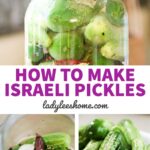

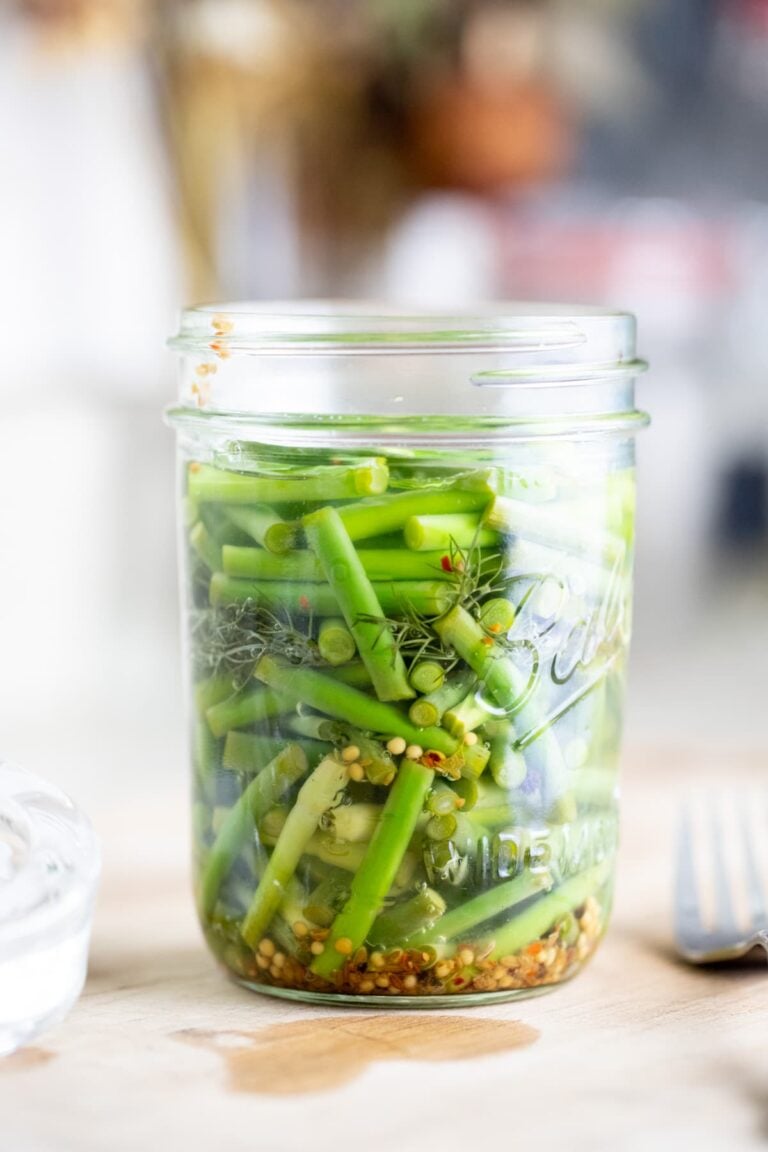
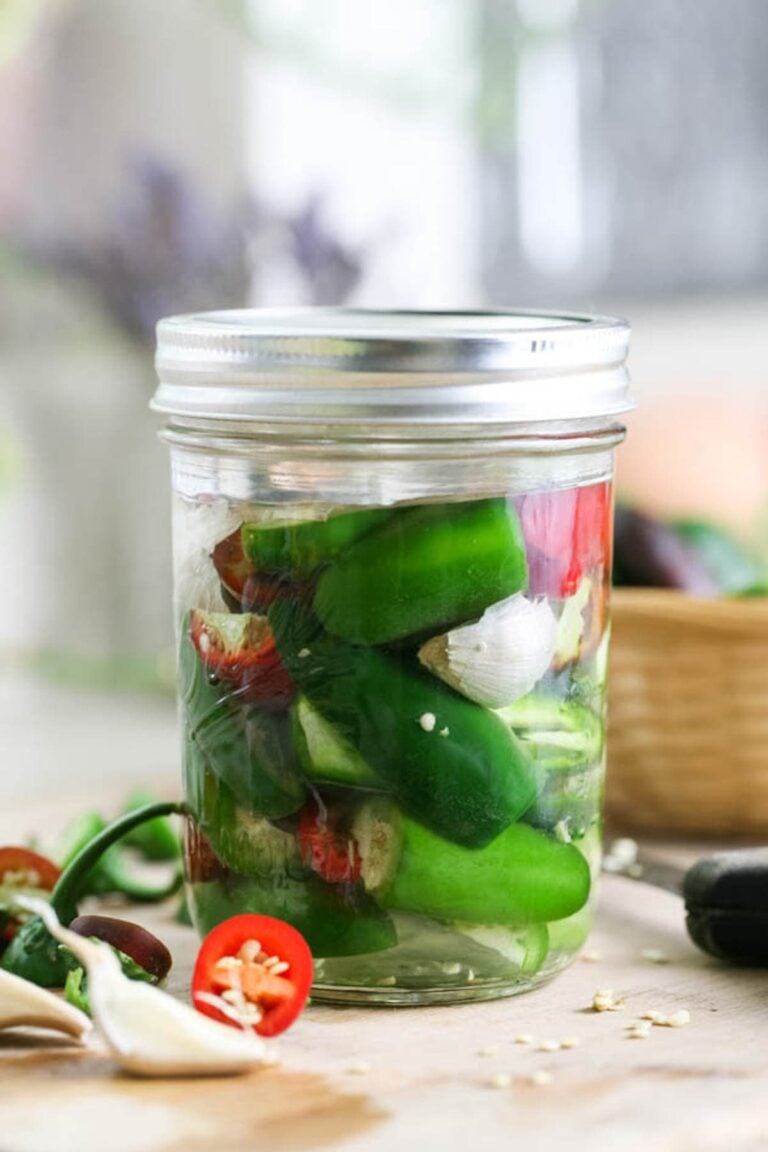
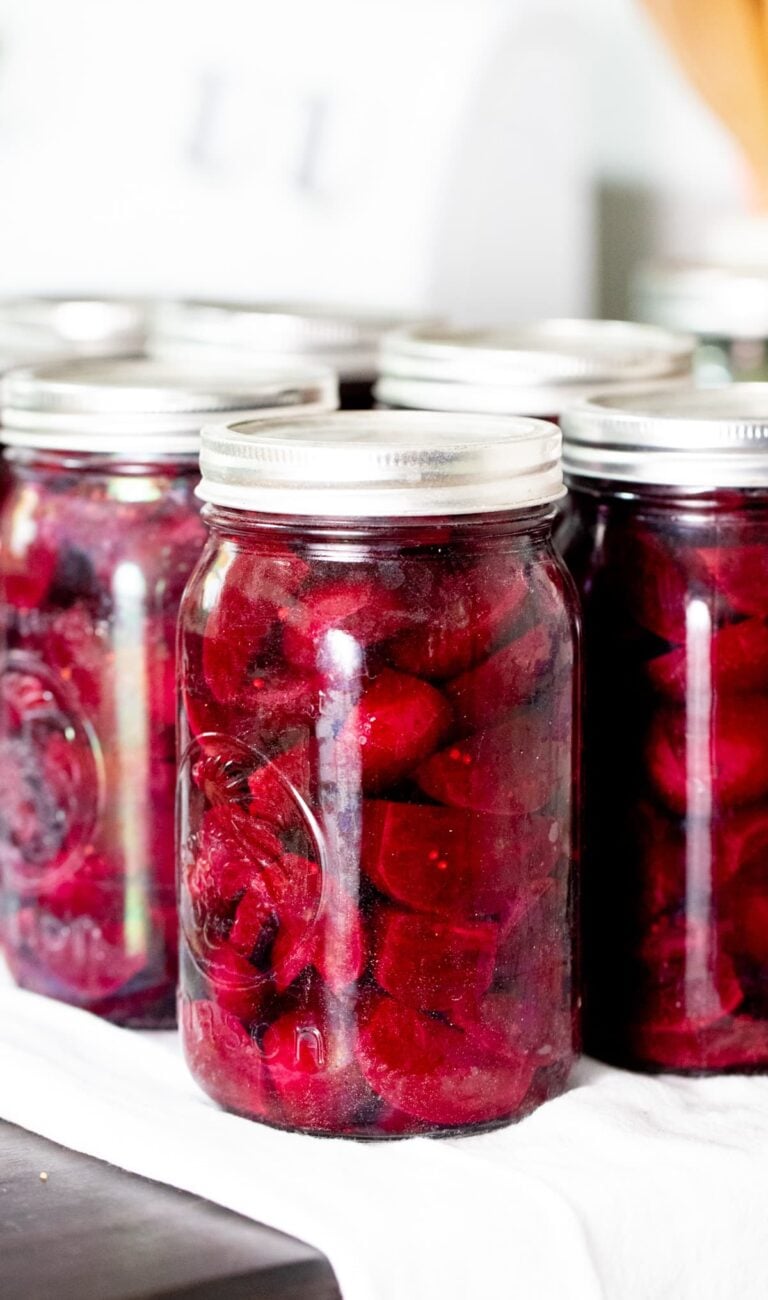

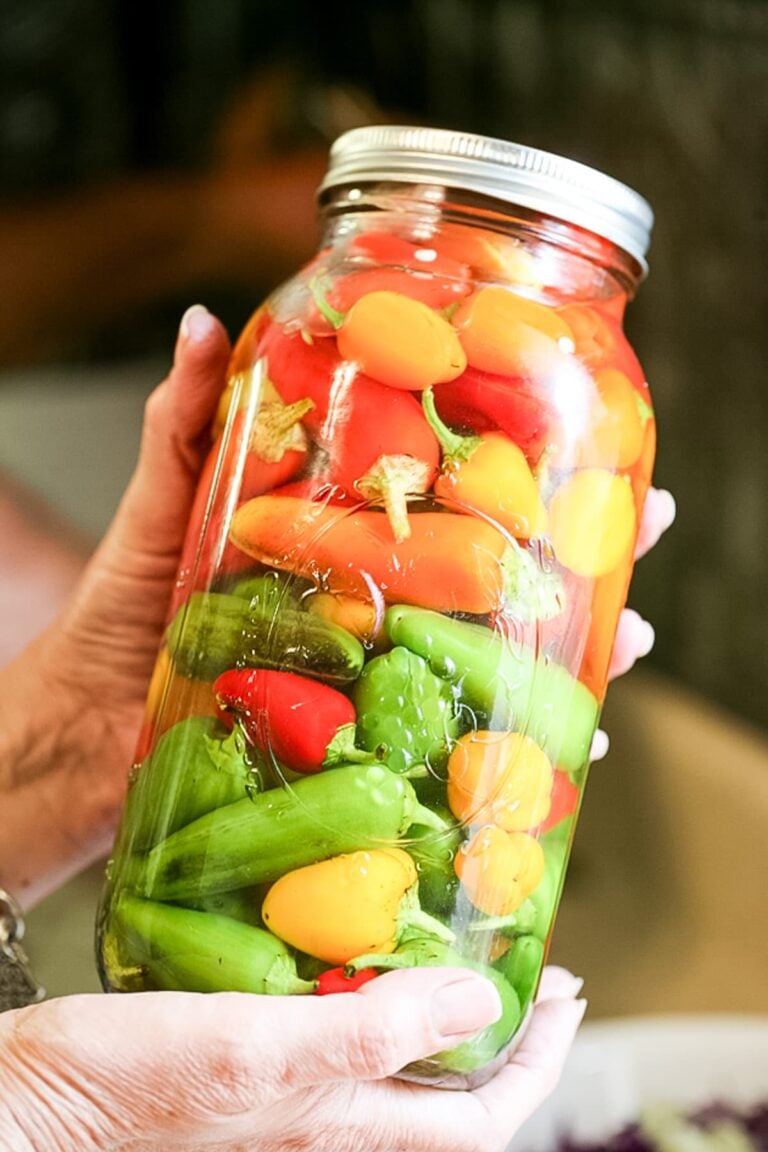
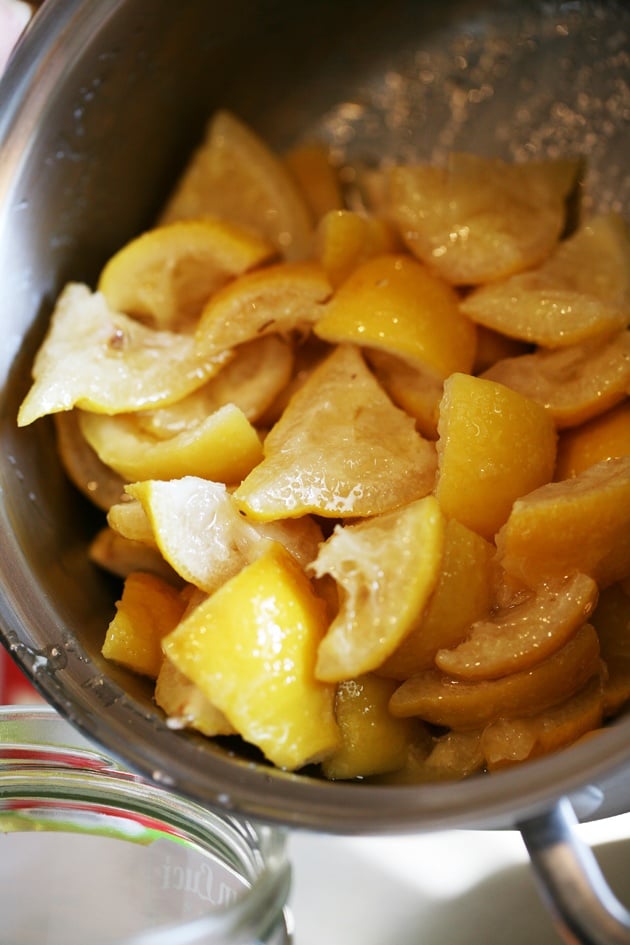
When making sauerkraut, I figure the amount of salt by weight, using two percent of the weight of the chopped cabbage. One kilo of cabbage requires 20 grams of salt.
I saw on another website that amount of salt in the brine should also be two percent of the weight of the water. Is this accurate?
Yes, you can do that too. It’s not an exact science. You can play with the amount of salt a bit. For me, it’s easier to use anywhere from a teaspoon to a tablespoon per cup of water than to weigh the vegetables. But if you prefer weighing, that’s fine.
I’ve always been daunted by pickling until seeing your video. With other people’s directions I’ve just been confused – but you’ve made it so simple and easy – thank you so much. I don’t like sugar or vinegar in my pickles and live in rural Australia where it’s difficult to source good pickles.
I have a question. I have jars that are 2 litres (which I think is approx half-gallon), and also I’ve been pickling some in smaller jars with the double lid.
A Rabbi on the tv suggested pickles would be ready in 3 days. Would the smaller jars be ready in 3 days. If you think longer how much longer would you give them. We grew the gherkins and they were pickled the day after they were picked.
Thank you
As long as you have a way to keep them in somewhat cold storage, lacto-fermenting is very easy and doesn’t use sugar or vinegar.
It does depend a bit on the kind of cucumber that you use, mainly their size, but I usually let a quart jar ferment for 5-7 days and a 1/2 gallon (2 litter) and gallon jars ferment for 10-14 days.
Thank you.
It’s very difficult in northern NSW to have a cool place to store them. Will have to think more on that.
I used a glass jar that’s almost 2 gallons and I used Albanian cucumbers that I deseeded and cut into spears. It’s been over a weeks and slight scent of garlic in the room a few days but never got cloudy. Any suggestions?
I wonder what kind of salt you used. Also, I never slice the cucumbers for this recipe because the salt makes them way too soft for me. I’ll give them another week at room temperature and then transfer them to the fridge and taste.
Hi Lady Lee! Many thanks for this great step-by-step tutorial to make lacto fermented cucumbers. I’m also a big fan of Israeli style pickles and where I live (Barcelona) I can’t find them in the stores. So, I found your Youtube channel and blog and decided to try it for myself. I have a question. This was my first time doing lacto fermentation and I followed your recipe at the detail. However, when after two weeks of fermentation I decided to try the cucumbers I found that instead of being crunchy, they were very limp and floppy and they were full of liquid inside. Do you have any explanation about it? Any hints will be appreciated!
Again many thanks and Hanukkah Sameach!
The crunchiness depends greatly on the kind of cucumbers that you used and their age. Did you use cucumbers from the store or from your garden? Do you know what variety of cucumbers you used?
Hanukkah sameach to you too!
Hi.
I find that a grape vine leaf or a tea bag that has no synthetic covering and no steel clip works to keep them crisp. It’s that tannin.
Hi, I just read this recipe with great interest. My Aunt used to make a salt brine pickle when I was a child. I used to love them.
She kept them in her unheated and unairconditioned closet/pantry in the country. She always said do not put your fingers in the crock. It had a plate on it and she said it would ruin them all. This was probably her method, I’m trying it today. With 2 T. salt.:-).
Oh! I hope you like them! I need to get me an old crock too.